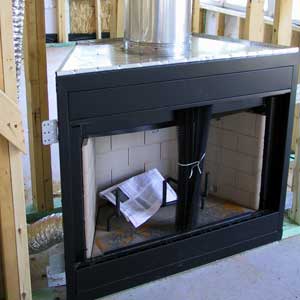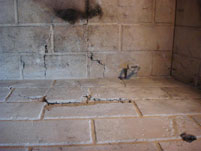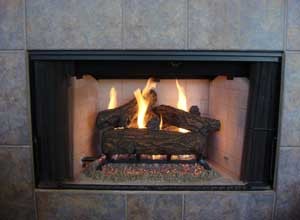 Prefab fireplace systems generally consist of a metal firebox, a metal flue pipe, and a chimney termination cap. The system is housed in a chimney structure constructed of wood framing and stucco and not red bricks and mortar. Prefab fireplaces are sometimes referred to as zero-clearance systems or “ZC’s.”
Prefab fireplace systems generally consist of a metal firebox, a metal flue pipe, and a chimney termination cap. The system is housed in a chimney structure constructed of wood framing and stucco and not red bricks and mortar. Prefab fireplaces are sometimes referred to as zero-clearance systems or “ZC’s.”
Prefab fireplaces are typically found in homes and condos built since the 1970s or during a remodel. Because a prefab fireplace looks similar to a standard masonry fireplace, the average homeowner cannot tell the difference.
The components in a prefab system have been tested by the prefab fireplace manufacturer in a U.L. lab and carry a U.L. listing.
For safety and liability reasons, these prefab fireplace systems should never be modified against the manufacturer’s specifications and the U.L. listing.
 Inside the firebox (where you make the fire), there are typically four panels. These panels are called refractory panels because they’re created with refractory cement and stamped to look like bricks. Typically there will be four panels–two sides, a back, and a floor–and the panels stand about two feet tall. These refractory panels can easily crack and can be expensive to replace.
Inside the firebox (where you make the fire), there are typically four panels. These panels are called refractory panels because they’re created with refractory cement and stamped to look like bricks. Typically there will be four panels–two sides, a back, and a floor–and the panels stand about two feet tall. These refractory panels can easily crack and can be expensive to replace.
Cracks in the refractory panels cause a potentially dangerous situation since they have lost their insulating ability and may transfer heat to combustible materials.
The primary cause for cracks developing in the refractory panels is having too big or too hot of a fire. Most of the prefab fireplace manufacturers recommend replacing a panel if you can fit the edge of a nickel inside the crack. These panels cannot be patched because the crack will come right back through the patch.
If you have a prefab fireplace, we highly recommend that you limit the size of your fires to either ONE artificial fire log (such as Duraflame or Pine Mountain) or just one to two small pieces of wood at a time.
Having large fires will guarantee that you will prematurely crack the fragile refractory panels.
Remember, these prefab fireplaces are not intended for heat, only for ambiance. If you’re getting heat from the fire, then you’re having too big of a fire and you risk cracking the fragile refractory panels.
Consider installing gas logs in your prefab fireplace. Because of the lower heat generated by gas logs, the risk of damaging the fragile refractory panels inside the firebox is greatly reduced.
These panels must be replaced with the manufacturer’s refractory panels and not by what are referred to as “universal” refractory panels or “after-market” refractory panels. They are also referred to as “cut-to-fit” panels. By installing refractory panels that are not the manufacturer’s listed parts, the U.L. listing on the entire prefab fireplace system is void because the system has been “modified against the manufacturer’s specifications.”
We recommend ONLY installing the manufacturer’s U.L. listed parts!
These prefab fireplaces have a limited lifespan. If the system has been properly maintained, manufacturers claim that the lifespan is upwards of 30 to 40 years. Prefab fireplace systems located close to the ocean will have a much shorter lifespan regardless of proper maintenance. Since the system is made from stainless steel, the salt in the ocean air may deteriorate the system faster than in a location where salt air isn’t present.

